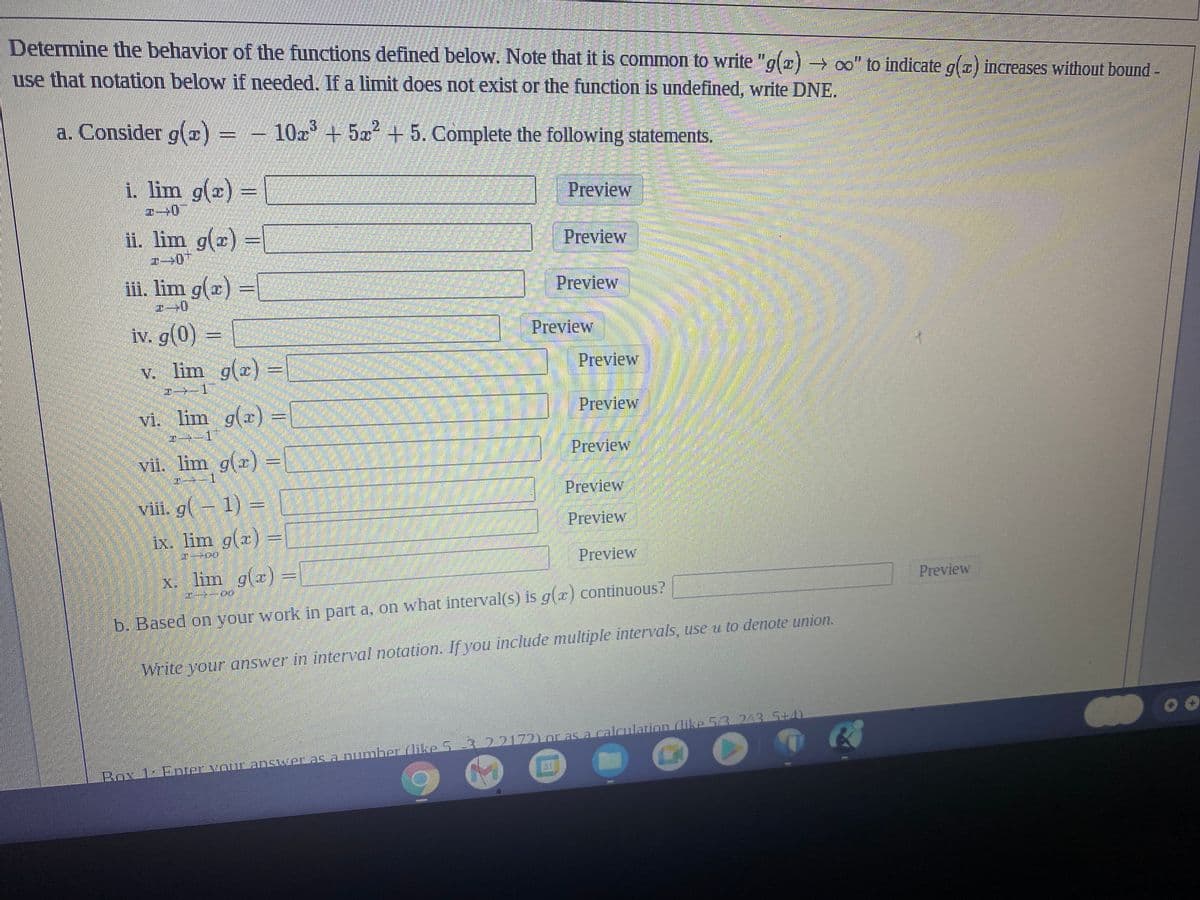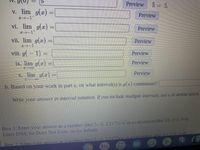Determine the behavior of the functions defined below. Note that it is common to write "g(z) → oo" to indicate g(z) increases without bound - use that notation below if needed. If a limit does not exist or the function is undefined, write DNE. a. Consider g(x) = 10x³ +52 +5. Complete the following statements. - i. lim g(x) = | Preview T-0 ii. lim g(x): Preview T-0 iii. lim g(x) = 2-0 iv. g(0) = Preview Preview
Determine the behavior of the functions defined below. Note that it is common to write "g(z) → oo" to indicate g(z) increases without bound - use that notation below if needed. If a limit does not exist or the function is undefined, write DNE. a. Consider g(x) = 10x³ +52 +5. Complete the following statements. - i. lim g(x) = | Preview T-0 ii. lim g(x): Preview T-0 iii. lim g(x) = 2-0 iv. g(0) = Preview Preview
Calculus: Early Transcendentals
8th Edition
ISBN:9781285741550
Author:James Stewart
Publisher:James Stewart
Chapter1: Functions And Models
Section: Chapter Questions
Problem 1RCC: (a) What is a function? What are its domain and range? (b) What is the graph of a function? (c) How...
Related questions
Question

Transcribed Image Text:Determine the behavior of the functions defined below. Note that it is common to write "g(2)→ ∞o" to indicate g() increases without bound -
use that notation below if needed. If a limit does not exist or the function is undefined, write DNE.
a. Consider g(x) =
10x³ +5² +5. Complete the following statements.
2
Preview
76
Preview
Preview
i. lim g(x) =
ii. lim g(x) =
iii. lim g(x) =
2-0
iv. g(0) =
v. lim g(x) =
1
vi. lim g(x) =
1
vii. lim g(x) =
viii. g(-1) =
ix. lim g(x)
TELEPO
Preview
x. lim g(x) =
*--00
b. Based on your work in part a, on what interval(s) is g(x) continuous?
Write your answer in interval notation. If you include multiple intervals, use u to denote union.
-3
Box 12 Enter your answer as a number (like 53 22172) or as a calculation (like 5/3 243 5+4)
Preview
Preview
Preview
Preview
Preview
Preview
Preview
FO
Expert Solution
This question has been solved!
Explore an expertly crafted, step-by-step solution for a thorough understanding of key concepts.
This is a popular solution!
Trending now
This is a popular solution!
Step by step
Solved in 2 steps with 1 images

Follow-up Questions
Read through expert solutions to related follow-up questions below.
Follow-up Question
Follow up questions

Transcribed Image Text:v. lim g(x) =
vi. lim g(x) =
--1
vii. lim g(x) =
I--1
viii. g( − 1) =
Preview
Preview
Preview
Preview
5 = 5.
Preview
Preview
ix. lim g(x) =
1-00
x. lim_g(x)
Preview
T-S-PO
b. Based on your work in part a, on what interval(s) is g(x) continuous?
Write your answer in interval notation. If you include multiple intervals, use u to denote union.
Box 1: Enter your answer as a number (like 5, -3, 2.2172) or as a calculation (like 5/3, 2^3, 5+4)
Enter DNE for Does Not Exist, oo for Infinity
R
G
Box 2: Enter your answer as a number (like 5. -3. 2.2172) or as a calculation (like 5/3. 243 5+4)
Solution
Follow-up Question

Transcribed Image Text:ii. lim g(2) –
5
iii. lim g(x) 5
I--0
iv. g(0) — 5
v. lim g(x)
→-17
vi. lim g(x)
vii. lim g(x)
PEN
viii. g(1)
Preview 5 = 5.
Preview 5 = 5.
55.
Preview
Preview
Preview
Preview
Preview
Preview
ix. lim g(x)
200
x. lim g(x)
Preview
b. Based on your work in part a, on what interval(s) is g(x) continuous?
Write your answer in interval notation. If you include multiple intervals, use u to denote union.
Box 1: Enter your answer as a number (like 5, -3, 2.2172) or as a calculation (like 5/3, 2/3, 5+4)
Erter DNF for Does Not Exist on for Infinity
G
▸
Preview
Solution
Recommended textbooks for you

Calculus: Early Transcendentals
Calculus
ISBN:
9781285741550
Author:
James Stewart
Publisher:
Cengage Learning

Thomas' Calculus (14th Edition)
Calculus
ISBN:
9780134438986
Author:
Joel R. Hass, Christopher E. Heil, Maurice D. Weir
Publisher:
PEARSON

Calculus: Early Transcendentals (3rd Edition)
Calculus
ISBN:
9780134763644
Author:
William L. Briggs, Lyle Cochran, Bernard Gillett, Eric Schulz
Publisher:
PEARSON

Calculus: Early Transcendentals
Calculus
ISBN:
9781285741550
Author:
James Stewart
Publisher:
Cengage Learning

Thomas' Calculus (14th Edition)
Calculus
ISBN:
9780134438986
Author:
Joel R. Hass, Christopher E. Heil, Maurice D. Weir
Publisher:
PEARSON

Calculus: Early Transcendentals (3rd Edition)
Calculus
ISBN:
9780134763644
Author:
William L. Briggs, Lyle Cochran, Bernard Gillett, Eric Schulz
Publisher:
PEARSON

Calculus: Early Transcendentals
Calculus
ISBN:
9781319050740
Author:
Jon Rogawski, Colin Adams, Robert Franzosa
Publisher:
W. H. Freeman


Calculus: Early Transcendental Functions
Calculus
ISBN:
9781337552516
Author:
Ron Larson, Bruce H. Edwards
Publisher:
Cengage Learning